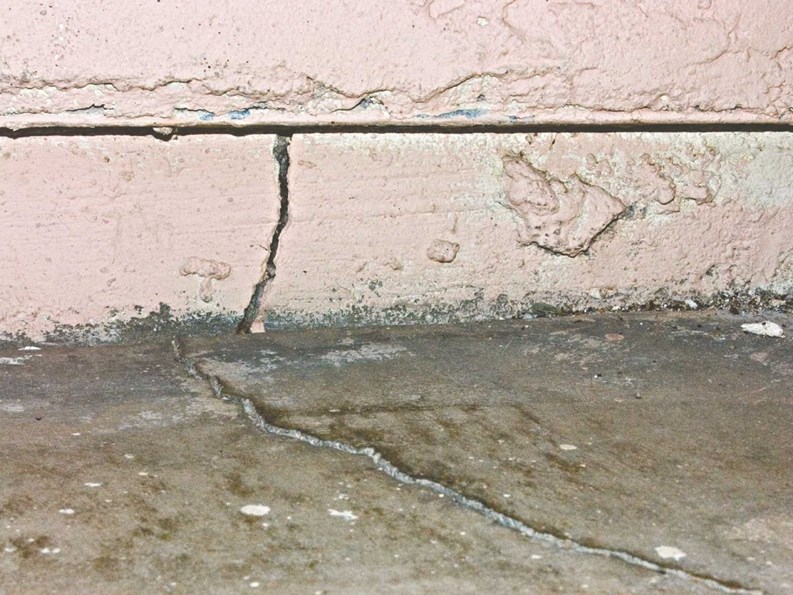They say a house is only as strong as its foundation. A bad roof or shoddy plumbing can set your building back a lot of money, of course—but a foundation in disrepair can put the entire building structure at risk. It can also cost tens of thousands of dollars. Since it's literally underground, it's easy to ignore, and can be difficult to inspect, but the health of a building's foundation is crucial. A little bit of education from the professionals can go a long way to raising anyone's awareness on the importance of a good building's foundation.
Every region has its own architectural quirks, but New Jersey's housing stock is pretty consistent when it comes to foundations. “The most common is a strip-footing foundation, which is a concrete footing that's required to be down at least to the frost line,” says William Pyznar, P.E., vice president and structural engineer at Falcon Engineering in Bridgewater. “You're going to see a similar type of foundation in most buildings, regardless of the age. There will just be some different materials, whether it be concrete or stone,” he says.
You might have heard the term “strip-footing” foundation before, but didn't go to engineering school. It’s usually comprised of “masonry blocks or poured concrete foundation walls sitting on top of poured concrete strip footing. Underneath a foundation wall—sometimes it's reinforced, sometimes it's not reinforced—what they do is they'll dig a trench at the base of the wall, there will be reinforcing steel in there. It's called a strip footing because it runs continuously underneath the wall to support it,” says Mark Yanchuk, P.E., AIA, LEED AP, vice president and structural engineer at Kipcon, Inc. in North Brunswick.
The types of foundations change when you get close to the Jersey Shore. “If you go into coastal areas where the soil doesn't have the proper capacity, you're going to see pile-type foundations. Those are wooden piles that are driven down to a depth that either the friction can hold the pile in place, or it goes down to the bedrock,” says Pyznar. “The other thing that you might have in coastal areas is what's called a mat foundation, and that's where a large concrete slab is poured to distribute the load over a large area of soil,” he says. Pyznar says the state has changed elevation requirements for the first floor because of Superstorm Sandy. But the foundation methods won't change.
Buildings on the shore face more challenges with their foundations. Salt water is very corrosive, and can damage the concrete over time. “In an area where you have piles, if you have pile caps that are exposed to the ocean, you might have some type of erosion or deterioration as a result of the salt, and storm waters over many years,” says Pyznar.
Though there's not a lot of variation among foundations in New Jersey, the earth around them can be quite different. Even though it is a relatively small state, New Jersey's geological makeup is comparatively diverse. The southern portion of the state consists mostly of sandy coastal plains. In the north, coastal plains converge with rocky formations that extend into the Appalachian Mountains.
“The soils will vary within the state,” says Yanchuk. “There's a lot of silty sands, and silty clays. More in North Jersey, there's more bedrock and some shale. New Jersey actually varies widely from the north portion of the state and the southern portion, where you get a lot of sands. It doesn't really affect the foundation too much. It affects more what the frost depth is. The frost depth is deeper in the north, and the code actually has different codes for the north and south.”
Soil can even vary on a local level. “You can find solid bedrock on the cliffs above the river in Edgewater, but when you come down into Edgewater, and you have the old softer riverbed. Within a quarter-mile of each other you can have completely different types of foundations. So it really depends on the geography,” says Pyznar.
Wherever you are, foundations can run into problems, and those problems can look different depending on what your foundation was built with. Before World War I, builders used anything from brick to stone. “The older homes, when they're built with masonry blocks, they were generally not reinforced,” says Yanchuk. Some home builders still opt not to reinforce foundation walls today, but Yanchuk says older homes without reinforcement tend to run into more issues years down the line.
The biggest external threat to foundations is water. Drainage is important for your typical foundations, where you have a foundation wall with a finished or unfinished base below grade. You want to move the water away from the foundation so it doesn't want to come into the foundation or below,” says Pyznar. “You don't want water to get into the building. You don't want erosion around the building, or pools of water.” Obviously, moisture can weaken the structural integrity of a building and cause all sorts of problem like mold.
But even if your basement is puddle-free you aren’t necessarily in the clear. Other signs of a foundation in trouble tend to be much more subtle, and depend on the type of foundation. “A lot of the problems I see are with foundation walls cracking. With masonry blocks, you'll see horizontal cracking along mortar joints. Whether it was maybe a frost heave event that kind of pushed the soil against the wall, and it wasn't reinforced, created a horizontal crack,” says Yanchuk. Cracking can affect how the building's weight is distributed, and over time, could cause added stress on external walls. Masonry blocks also show leakage in a different way than concrete. “If it is compromising the waterproofing on the outside, it will leak. A similar crack on a block wall, you may not see the evidence of the leak right away, because it will fill up the pores of the block. So you may see the leak in a different way. It may just leak at the bottom, or get wet at the bottom,” says Yanchuk.
With concrete, similar problems arise, but they look different. “In the poured concretes, a lot of the times you'll see vertical cracks. A lot of it is associated with shrinkage,” says Yanchuk. Though concrete is one of the strongest construction materials known to man, it is ironically temperamental before it dries. If it's mixed too dry, too wet, or at a bad temperature, concrete can crumble and crack once it dries. Pouring concrete when it's too cold can also cause major issues unless you take means to protect it. That said, concrete doesn't have to be perfect to do its job. “A lot of the cracks you'll find in the poured concrete foundations are normal to a degree. The problem is, is that a lot of those cracks leak, so you will get complaints from homeowners,” says Yanchuk.
More recently built multi-family units will have a concrete foundation. Since unit owners have no involvement in construction, they should take certain steps to confirm the soundness of their foundation. “Condos would have to worry about construction defects after they've been built. During the construction phase, the builders go through a process of necessary inspections that the state requires. Once there's an inspection and excavation, there's an inspection when the footing is poured, before you can construct, and you know, the local municipalities do that, “ says Pyznar. “But once the building is built and you can no longer see those footings or how the foundation's constructed, the condo association does have to worry about defects that they can't see. And they're only going to know about the defects if there is water infiltration or cracks, or failures of the footing,” he says.
Therefore, it's crucial for a condo association to vet a building during the transition from developers. Especially in larger projects, developers have a tendency to cut corners, so deadlines and schedules get met. During the transition, the association can hire a professional engineer to go out and perform a defect study. “They'll look at the plans, look at the construction, look for signs of defects, whether it is water infiltration or cracks, beyond what might be anticipated,” says Pyznar. “Once that's done, that's their opportunity to go back to the developer.”
Once the building is formally handed over to the association, if no defects in construction are documented, the association will be more likely to be on the hook for future problems. “So it's really one shot. In the future, if that process had happened and things come up, they still have an opportunity to identify defects. If people are starting to have a lot of water infiltration or cracks, they should hire an engineer to see if it's systemic or not,” says Pyznar.
Generally, associations should rather be safe than sorry. If someone sees a crack or abnormality in your building's foundation, make sure a pair of trained eyes get a look. “The way the wall cracks, the shape of the crack, where it's located, the thickness of the crack—these all mean something and need to be interpreted. They should bring in a professional to interpret what it means,” says Yanchuk.
W. B. King is a freelance writer and a frequent contributor to the New Jersey Cooperator. Editorial Assistant Tom Lisi contributed to this article.







Leave a Comment